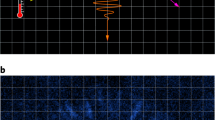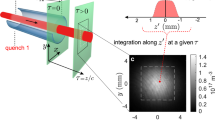Abstract
In most cosmological models, rapid expansion of space marks the first moments of the Universe and leads to the amplification of quantum fluctuations1. The description of subsequent dynamics and related questions in cosmology requires an understanding of the quantum fields of the standard model and dark matter in curved spacetime. Even the reduced problem of a scalar quantum field in an explicitly time-dependent spacetime metric is a theoretical challenge2,3,4,5, and thus a quantum field simulator can lead to insights. Here we demonstrate such a quantum field simulator in a two-dimensional Bose–Einstein condensate with a configurable trap6,7 and adjustable interaction strength to implement this model system. We explicitly show the realization of spacetimes with positive and negative spatial curvature by wave-packet propagation and observe particle-pair production in controlled power-law expansion of space, using Sakharov oscillations to extract amplitude and phase information of the produced state. We find quantitative agreement with analytical predictions for different curvatures in time and space. This benchmarks and thereby establishes a quantum field simulator of a new class. In the future, straightforward upgrades offer the possibility to enter unexplored regimes that give further insight into relativistic quantum field dynamics.
This is a preview of subscription content, access via your institution
Access options
Access Nature and 54 other Nature Portfolio journals
Get Nature+, our best-value online-access subscription
$29.99 / 30 days
cancel any time
Subscribe to this journal
Receive 51 print issues and online access
$199.00 per year
only $3.90 per issue
Buy this article
- Purchase on Springer Link
- Instant access to full article PDF
Prices may be subject to local taxes which are calculated during checkout





Similar content being viewed by others
Data availability
The datasets generated and analysed during the current study are available from the corresponding author.
Code availability
The conclusions of this study do not depend on code or algorithms beyond standard numerical evaluations.
References
Weinberg, S. Cosmology (Oxford Univ. Press, 2008).
Schrödinger, E. The proper vibrations of the expanding universe. Physica 6, 899–912 (1939).
Parker, L. Quantized fields and particle creation in expanding universes. I. Phys. Rev. 183, 1057–1068 (1969).
Birrell, N. D. & Davies, P. C. W. Quantum Fields in Curved Space (Cambridge Monographs on Mathematical Physics, Cambridge Univ. Press, 1982).
Mukhanov, V. & Winitzki, S. Introduction to Quantum Effects in Gravity (Cambridge Univ. Press, Cambridge, 2007).
Saint-Jalm, R. et al. Dynamical symmetry and breathers in a two-dimensional Bose gas. Phys. Rev. X 9, 021035 (2019).
Gauthier, G. et al. in Advances in Atomic, Molecular, and Optical Physics Vol. 70 (eds Dimauro, L. F. et al.) Ch. 1, 1–101 (Academic Press, 2021).
Unruh, W. G. Experimental black-hole evaporation? Phys. Rev. Lett. 46, 1351–1353 (1981).
Unruh, W. G. Sonic analogue of black holes and the effects of high frequencies on black hole evaporation. Phys. Rev. D 51, 2827–2838 (1995).
Garay, L. J., Anglin, J. R., Cirac, J. I. & Zoller, P. Sonic analog of gravitational black holes in Bose–Einstein condensates. Phys. Rev. Lett. 85, 4643–4647 (2000).
Visser, M., Barceló, C. & Liberati, S. Analogue models of and for gravity. Gen. Relativ. Gravit. 34, 1719–1734 (2002).
Novello, M., Visser, M. & Volovik, G. E. (eds) Artificial Black Holes (World Scientific Publishing, 2002).
Barceló, C., Liberati, S. & Visser, M. Probing semiclassical analog gravity in Bose–Einstein condensates with widely tunable interactions. Phys. Rev. A 68, 053613 (2003).
Fedichev, P. O. & Fischer, U. R. “Cosmological” quasiparticle production in harmonically trapped superfluid gases. Phys. Rev. A 69, 033602 (2004).
Jain, P., Weinfurtner, S., Visser, M. & Gardiner, C. W. Analog model of a Friedmann–Robertson–Walker universe in Bose–Einstein condensates: application of the classical field method. Phys. Rev. A 76, 033616 (2007).
Schützhold, R. Recreating fundamental effects in the laboratory?. Adv. Sci. Lett. 2, 121–132 (2009).
Prain, A., Fagnocchi, S. & Liberati, S. Analogue cosmological particle creation: quantum correlations in expanding Bose–Einstein condensates. Phys. Rev. D 82, 105018 (2010).
Barceló, C., Liberati, S. & Visser, M. Analogue gravity. Living Rev. Relativ. 14, 3 (2011).
Jacquet, M. J., Weinfurtner, S. & König, F. The next generation of analogue gravity experiments. Phil. Trans. R Soc. A 378, 20190239 (2020).
Philbin, T. G. et al. Fiber-optical analog of the event horizon. Science 319, 1367–1370 (2008).
Weinfurtner, S., Tedford, E. W., Penrice, M. C. J., Unruh, W. G. & Lawrence, G. A. Measurement of stimulated Hawking emission in an analogue system. Phys. Rev. Lett. 106, 021302 (2011).
Carusotto, I., Fagnocchi, S., Recati, A., Balbinot, R. & Fabbri, A. Numerical observation of Hawking radiation from acoustic black holes in atomic Bose–Einstein condensates. New J. Phys. 10, 103001 (2008).
Lahav, O. et al. Realization of a sonic black hole analog in a Bose–Einstein condensate. Phys. Rev. Lett. 105, 240401 (2010).
Steinhauer, J. Observation of self-amplifying Hawking radiation in an analogue black-hole laser. Nat. Phys. 10, 864–869 (2014).
Eckel, S., Kumar, A., Jacobson, T., Spielman, I. B. & Campbell, G. K. A rapidly expanding Bose–Einstein condensate: an expanding universe in the lab. Phys. Rev. X 8, 021021 (2018).
Muñoz de Nova, J. R., Golubkov, K., Kolobov, V. I. & Steinhauer, J. Observation of thermal Hawking radiation and its temperature in an analogue black hole. Nature 569, 688–691 (2019).
Wittemer, M. et al. Phonon pair creation by inflating quantum fluctuations in an ion trap. Phys. Rev. Lett. 123, 180502 (2019).
Banik, S. et al. Accurate determination of Hubble attenuation and amplification in expanding and contracting cold-atom universes. Phys. Rev. Lett. 128, 090401 (2022).
D'Errico, C. et al. Feshbach resonances in ultracold 39K. New J. Phys. 9, 223 (2007).
Jaskula, J.-C. et al. Acoustic analog to the dynamical Casimir effect in a Bose–Einstein condensate. Phys. Rev. Lett. 109, 220401 (2012).
Hung, C.-L., Gurarie, V. & Chin, C. From cosmology to cold atoms: observation of Sakharov oscillations in a quenched atomic superfluid. Science 341, 1213–1215 (2013).
Chen, C.-A., Khlebnikov, S. & Hung, C.-L. Observation of quasiparticle pair production and quantum entanglement in atomic quantum gases quenched to an attractive interaction. Phys. Rev. Lett. 127, 060404 (2021).
Steinhauer, J. et al. Analogue cosmological particle creation in an ultracold quantum fluid of light. Nat. Commun. 13, 2890 (2022).
Tolosa-Simeón, M. et al. Curved and expanding spacetime geometries in Bose–Einstein condensates. Phys. Rev. A 106, 033313 (2022).
Gross, C. et al. Atomic homodyne detection of continuous-variable entangled twin-atom states. Nature 480, 219–223 (2011).
Sakharov, A. D. The initial stage of an expanding Universe and the appearance of a nonuniform distribution of matter. Sov. Phys. JETP 22, 241–249 (1966).
Grishchuk, L. P. Cosmological Sakharov oscillations and quantum mechanics of the early Universe. Phys. Uspekhi 55, 210 (2012).
Giorgini, S., Pitaevskii, L. P. & Stringari, S. Condensate fraction and critical temperature of a trapped interacting Bose gas. Phys. Rev. A 54, R4633 (1996).
Berges, J., Floerchinger, S. & Venugopalan, R. Dynamics of entanglement in expanding quantum fields. J. High Energy Phys. 2018, 145 (2018).
Robertson, S., Michel, F. & Parentani, R. Controlling and observing nonseparability of phonons created in time-dependent 1D atomic Bose condensates. Phys. Rev. D 95, 065020 (2017).
Kunkel, P. et al. Detecting entanglement structure in continuous many-body quantum systems. Phys. Rev. Lett. 128, 020402 (2022).
Gibbons, G. W. & Hawking, S. W. Cosmological event horizons, thermodynamics, and particle creation. Phys. Rev. D 15, 2738–2751 (1977).
Jacobson, T. Thermodynamics of spacetime: the Einstein equation of state. Phys. Rev. Lett. 75, 1260–1263 (1995).
Jacobson, T. Entanglement equilibrium and the Einstein equation. Phys. Rev. Lett. 116, 201101 (2016).
Fischer, U. R. & Schützhold, R. Quantum simulation of cosmic inflation in two-component Bose–Einstein condensates. Phys. Rev. A 70, 063615 (2004).
Schmidt-May, A. & von Strauss, M. Recent developments in bimetric theory. J. Phys. A 49, 183001 (2016).
Hans, M. et al. High signal to noise absorption imaging of alkali atoms at moderate magnetic fields. Rev. Sci. Instrum. 92, 023203 (2021).
Volovik, G. E. The Universe in a Helium Droplet (Oxford Univ. Press, 2009).
Bilić, N. & Tolić, D. FRW universe in the laboratory. Phys. Rev. D 88, 105002 (2013).
Sánchez-Kuntz, N., Parra-López, Á., Tolosa-Simeón, M., Haas, T. & Floerchinger, S. Scalar quantum fields in cosmologies with 2 + 1 spacetime dimensions. Phys. Rev. D 105, 105020 (2022).
Acknowledgements
We thank S. Brunner and F. Schmutte for discussions. This work is supported by the Deutsche Forschungsgemeinschaft (DFG, German Research Foundation) under Germany’s Excellence Strategy EXC 2181/1 - 390900948 (the Heidelberg STRUCTURES Excellence Cluster) and under SFB 1225 ISOQUANT - 273811115, as well as FL 736/3-1. N.L. acknowledges support by the Studienstiftung des Deutschen Volkes. N.S.-K. is supported by the Deutscher Akademischer Austauschdienst (DAAD, German Academic Exchange Service) under the Länderbezogenes Kooperationsprogramm mit Mexiko: CONACYT Promotion, 2018 (57437340). Á.P.-L. is supported by the MIU (Ministerio de Universidades, Spain) fellowship FPU20/05603 and the MICINN (Ministerio de Ciencia e Innovación, Spain) project PID2019-107394GB-I00 (AEI/FEDER,UE).
Author information
Authors and Affiliations
Contributions
The experimental concept was developed in discussion among all authors. M.H., E.K., N.L., M.K.O., M.S., H.S. and C.V. controlled the experimental apparatus, discussed the measurement results and analysed the data. S.F., T.H., Á.P.-L., N.S.-K. and M.T.-S. elaborated the theoretical framework. All authors contributed to the discussion of the results and the writing of the manuscript.
Corresponding author
Ethics declarations
Competing interests
The authors declare no competing interests.
Peer review
Peer review information
Nature thanks Silke Weinfurtner and the other, anonymous, reviewer(s) for their contribution to the peer review of this work.
Additional information
Publisher’s note Springer Nature remains neutral with regard to jurisdictional claims in published maps and institutional affiliations.
Extended data figures and tables
Extended Data Fig. 1 Theoretical prediction for density-contrast correlation functions in real space.
The initial temperature is taken to be 40 nK, the final speed of sound is 1.2 µm ms−1 and the ramp goes from as = 350aB to as = 50aB with scale factor a(t) ∝ tγ for a decelerated expansion with γ = 0.5 and a duration ∆t = 1.5 ms (left) and ∆t = 3.0 ms (right). The fields are convoluted with a Gaussian of σ = 0.8 µm corresponding to the optical resolution of the experiment. Different colours correspond to different hold times.
Rights and permissions
Springer Nature or its licensor (e.g. a society or other partner) holds exclusive rights to this article under a publishing agreement with the author(s) or other rightsholder(s); author self-archiving of the accepted manuscript version of this article is solely governed by the terms of such publishing agreement and applicable law.
About this article
Cite this article
Viermann, C., Sparn, M., Liebster, N. et al. Quantum field simulator for dynamics in curved spacetime. Nature 611, 260–264 (2022). https://doi.org/10.1038/s41586-022-05313-9
Received:
Accepted:
Published:
Issue Date:
DOI: https://doi.org/10.1038/s41586-022-05313-9
This article is cited by
-
Rotating curved spacetime signatures from a giant quantum vortex
Nature (2024)
-
Low-dimensional quantum gases in curved geometries
Nature Reviews Physics (2023)
-
Does Hawking effect always degrade fidelity of quantum teleportation in Schwarzschild spacetime?
Journal of High Energy Physics (2023)
-
Classifying quantum steering, entanglement, and discord for continuous variables in Schwarzschild spacetime
Quantum Information Processing (2023)
-
Superfluid system hosts early-Universe dynamics
Nature (2022)
Comments
By submitting a comment you agree to abide by our Terms and Community Guidelines. If you find something abusive or that does not comply with our terms or guidelines please flag it as inappropriate.



